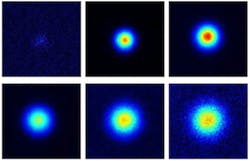Experiment proves Anderson localization, a limit on light propagation in turbid media
Zurich, Switzerland and Konstanz, Germany--Physicists from the universities of Zurich and Konstanz have now experimentally proven Nobel Prize winner Philip Anderson’s theory that waves do not spread in a disordered medium if there is less than one wavelength between two defects.1 The researchers demonstrated this directly using the diffusion of light in a cloudy medium for the first time. (Other experiments have previously shown this effect in, for example, matter waves. The effect has also been previously shown to exist in a photonic medium, but the demonstration did not show things directly via imaging.)
Light cannot spread in a straight line in a turbid medium like milk because the many particles serve as defects and scatter the light. If the disorder (the concentration of defects) exceeds a certain level, the waves can no longer spread at all. Philip Anderson was the first to describe this transition to a localized wave in 1958. Until now, however, Anderson localization had never been observed directly in light.
The new experiment shows that Anderson localization of light only occurs in much cloudier media than milk—in fact, only if there is a maximum of about one wavelength between two defects.
Propagation imaged at nanosecond rates
For their study, the team examined the diffusion of light in a number of strongly scattering media (with different localization lengths) and at different wavelengths from 550 to 650 nm. “To make the diffusion of the light and thus Anderson localization visible, pictures had to be taken at an interval of less than a billionth of a second,” says Christof Ägerter, one of the University of Zurich researchers. Based on these high-resolution images, the researchers showed that light stops spreading in the medium after around 4 ns when under the effects of Anderson localization.
Calculating certain characteristics of localized states, such as how large the critical concentration of defects is, is difficult. “Thanks to our experimental data, the theory will gain new impetus and be able to be refined further,” says Ägerter.
Anderson localization is a general phenomenon that occurs in all types of waves undergoing heavy scattering. It is of practical importance in many fields besides photonics: It describes, among other things, the transition between a conductor and an insulator.
REFERENCE:
1. T. Sperling et al., Nature Photonics (2012). DOI: 10.1038/NPHOTON.2012.313

John Wallace | Senior Technical Editor (1998-2022)
John Wallace was with Laser Focus World for nearly 25 years, retiring in late June 2022. He obtained a bachelor's degree in mechanical engineering and physics at Rutgers University and a master's in optical engineering at the University of Rochester. Before becoming an editor, John worked as an engineer at RCA, Exxon, Eastman Kodak, and GCA Corporation.
